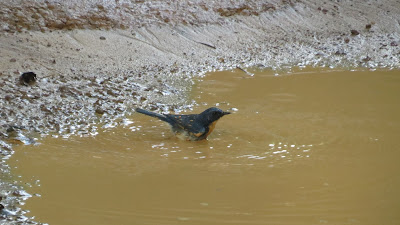Tickell's blue flycatcher (Cyornis tickelliae) is a small passerine bird in the flycatcher family. This is an insectivorous species which breeds in tropical Asia, from the Indian Subcontinent eastwards to Southeast Asia. Its range stretches across all the countries from India to Indonesia. They are blue on the upperparts and the throat and breast are rufous. They are found in dense scrub to forest habitats.
The name commemorates the British ornithologist Samuel Tickell who collected in India and Burma.
ickell's blue flycatcher is about 11–12 cm long. It sits upright and
forages mainly in the overgrowth. The male's upper parts are bright
blue, its throat and breast are red, and the rest of the underparts are
white. The female is duller blue with a brighter blue brow, shoulder,
rump, and tail. It hybridizes with the pale-chinned blue flycatcher (Cyornis poliogenys) in the Eastern Ghats of India and these hybrids have sometimes been called the subspecies vernayi.
The juvenile is streaked and has a spotted mantle, scaly brown
upper parts, head and breast, with just the wings and tail being blue.
They have sometimes been known to feed even after dusk. Apart from flying insects they have been noted to occasionally glean crawling insects. The widespread species shows regional variations in plumage and size and
several of these populations have been designated with subspecies
names. The nominate form is found in India, Nepal and Myanmar. The Sri
Lankan population is separated as jerdoni (or nesea/mesaea said to be darker) and the population in Thailand and southern Myanmar is named as indochina. Further south is the form sumatrensis (Sumatra Island, Malaysia) and lamprus on Anamba Island.
In the past this species has been considered as a subspecies of the blue-throated blue flycatcher (Cyornis rubeculoides) which resembles this but has a blue throat.
Tickell's blue flycatcher breeds in dry forest, scrub, bamboo and gardens.
The metallic song of the bird includes a series of clicks followed by five or six notes that end abruptly. The metallic song consists of short clicks followed by five or six
notes resembling that of the white-browed fantail-flycatcher. Alarm
calls include churr and clicking notes. It is a wary bird and not always easily observed. It is a forest-loving
species which is found in thick cover and shade, and particularly
haunts the banks of wooded streams.
They feed mainly by capturing insects in flight but their prey
include other insects such as termites and earwigs that may be gleaned
or picked from the ground.
The breeding season is April to August (March to June in Sri Lanka).
It nests in a hole in a tree or amongst rocks that is lined with fine
grass and fibres and lay 3–5 eggs.
Captured @ Wilpattu National Park....



No comments:
Post a Comment